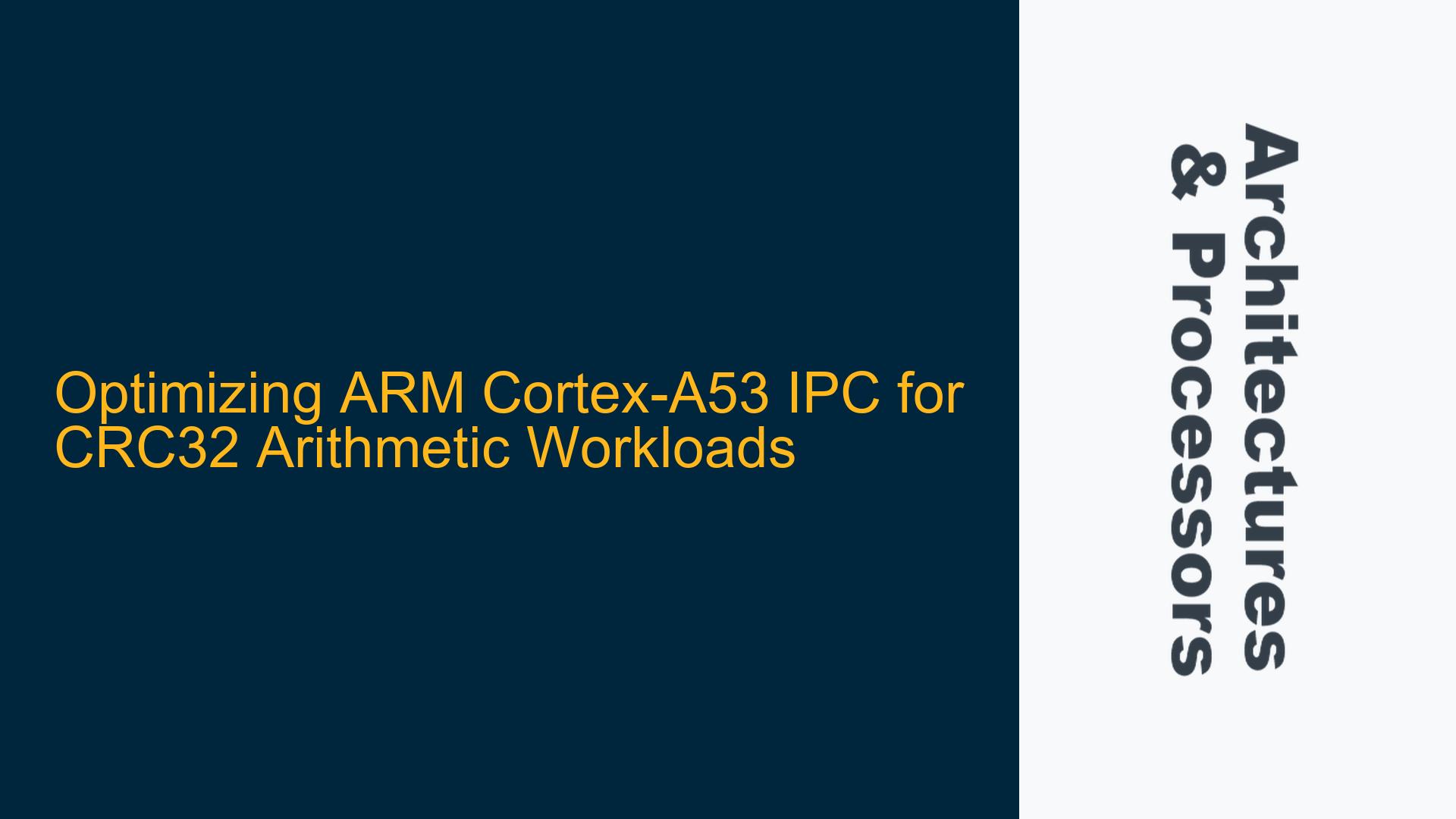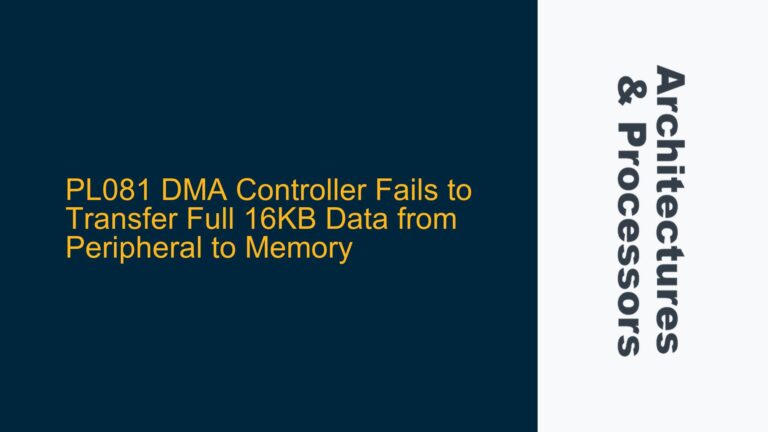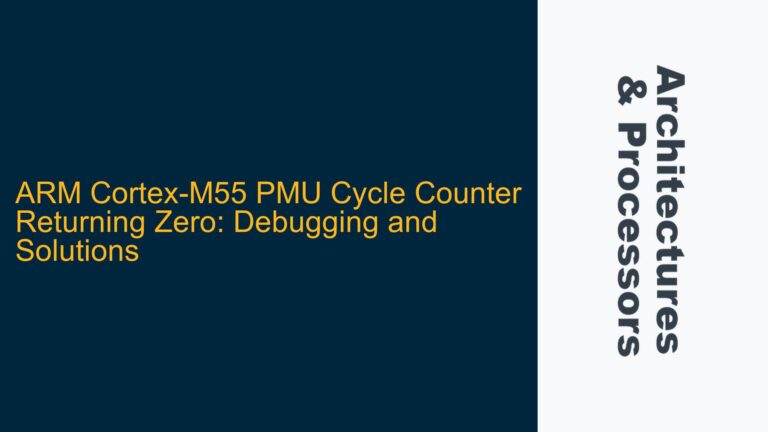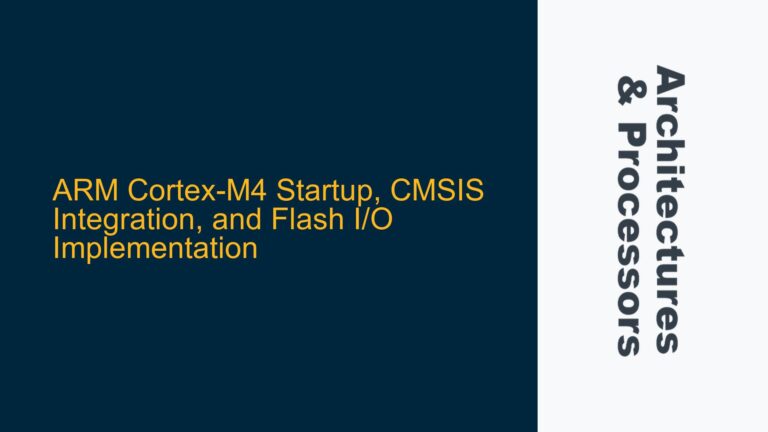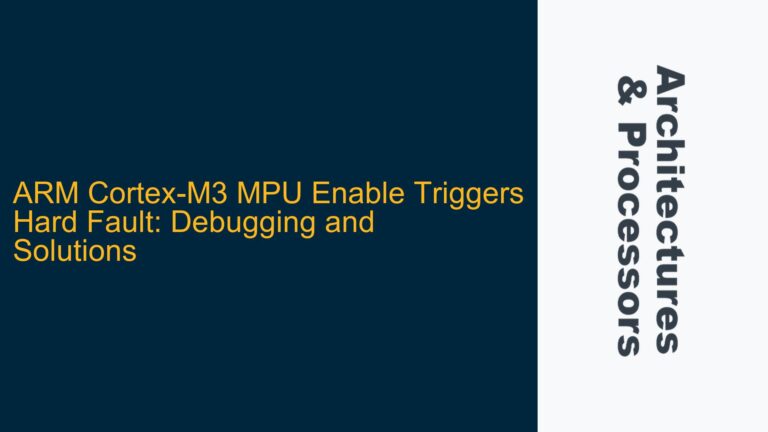ARM Cortex-A53 Instruction Per Cycle (IPC) Analysis for CRC32 Workloads
The ARM Cortex-A53 is a widely used in-order processor core designed for efficiency and low power consumption. It features a dual-issue pipeline, meaning it can theoretically execute up to two instructions per cycle under optimal conditions. However, achieving this peak IPC is highly dependent on the nature of the workload, instruction scheduling, and memory access patterns. In the context of CRC32 arithmetic operations, which involve polynomial calculations, data movement, and comparison tasks, the observed IPC of 1.05 suggests that there is room for improvement. This analysis delves into the architectural constraints of the Cortex-A53, identifies potential bottlenecks, and provides actionable steps to optimize IPC for such workloads.
The Cortex-A53’s in-order execution pipeline means that instructions are executed in the order they are fetched, and any stall—whether due to data dependencies, cache misses, or resource contention—can significantly impact performance. Additionally, the core has specific limitations, such as a single load/store pipeline and a single integer multiplier, which can further constrain IPC. Understanding these limitations and tailoring the code to mitigate their impact is crucial for achieving higher IPC.
In-Order Pipeline Constraints and Resource Contention
The Cortex-A53’s in-order pipeline is one of the primary factors influencing IPC. Unlike out-of-order processors, which can reorder instructions dynamically to hide latency, the Cortex-A53 must execute instructions strictly in sequence. This makes it particularly sensitive to instruction dependencies and memory access patterns. For example, if a load instruction is followed by an instruction that depends on the loaded data, the pipeline will stall until the data is available. In the context of CRC32 workloads, where data is frequently moved and compared, such stalls can significantly reduce IPC.
Another critical factor is resource contention. The Cortex-A53 has two integer pipelines, but only one of them supports multiplication operations. This means that if the workload involves a high frequency of multiplications (as is often the case in CRC32 calculations), the second integer pipeline may remain underutilized. Similarly, the single load/store pipeline can become a bottleneck if the workload involves frequent memory accesses. These constraints must be carefully managed to maximize IPC.
Optimizing Instruction Scheduling and Cache Utilization
To achieve higher IPC on the Cortex-A53, it is essential to optimize instruction scheduling and cache utilization. Instruction scheduling involves reordering instructions to minimize pipeline stalls and maximize dual-issue opportunities. For example, independent instructions can be interleaved with dependent instructions to keep both pipelines busy. Additionally, reducing the number of load-use dependencies—where an instruction depends on the result of a load operation—can help avoid pipeline stalls.
Cache utilization is another critical aspect. The Cortex-A53 has separate L1 instruction and data caches, and efficient use of these caches can significantly improve performance. For CRC32 workloads, which involve frequent data movement and comparison, ensuring that data is kept in the L1 cache can reduce memory access latency and improve IPC. Techniques such as loop unrolling, data prefetching, and aligning data structures to cache line boundaries can help achieve this.
Implementing Data Prefetching and Loop Unrolling
Data prefetching is a technique that involves loading data into the cache before it is needed, thereby reducing memory access latency. In the context of CRC32 workloads, where data is processed in chunks, prefetching the next chunk of data while the current chunk is being processed can help keep the pipeline busy. The Cortex-A53 supports both explicit prefetch instructions and implicit prefetching through cache line fills. Using these mechanisms effectively can improve IPC by reducing the impact of memory access latency.
Loop unrolling is another technique that can improve IPC by reducing the overhead of loop control instructions. By unrolling loops, multiple iterations of the loop can be executed in parallel, increasing the number of independent instructions available for dual-issue. However, care must be taken to balance the benefits of loop unrolling with the increased code size and potential cache pressure it can cause. For CRC32 workloads, where the loop body typically involves arithmetic operations and data movement, moderate loop unrolling can be beneficial.
Leveraging NEON for Parallel Processing
The Cortex-A53 includes a NEON SIMD (Single Instruction, Multiple Data) unit, which can be used to accelerate parallel processing tasks. While NEON is typically associated with multimedia and signal processing workloads, it can also be leveraged for CRC32 calculations. By processing multiple data elements in parallel using NEON instructions, the workload can be distributed across the vector pipeline, reducing the reliance on the integer pipelines and improving overall IPC.
However, using NEON effectively requires careful consideration of data alignment and access patterns. NEON instructions operate on 64-bit or 128-bit vectors, so data must be aligned accordingly to avoid performance penalties. Additionally, the overhead of loading data into NEON registers and storing the results back to memory must be accounted for. For CRC32 workloads, where the data is often in 32-bit chunks, packing multiple 32-bit values into NEON registers can help achieve higher throughput.
Profiling and Benchmarking for Targeted Optimization
Profiling and benchmarking are essential tools for identifying performance bottlenecks and guiding optimization efforts. By using performance counters available on the Cortex-A53, it is possible to measure metrics such as IPC, cache hit rates, and pipeline stalls. These metrics can provide valuable insights into where the bottlenecks lie and which optimization techniques are likely to yield the greatest improvements.
For CRC32 workloads, profiling can help identify specific instructions or code segments that are causing pipeline stalls or cache misses. For example, if profiling reveals that a significant portion of the execution time is spent waiting for memory accesses, techniques such as data prefetching or cache alignment can be applied. Similarly, if the profiling data shows that the integer multiplier is heavily utilized, alternative algorithms or instruction scheduling techniques can be explored to reduce contention.
Conclusion: Achieving Higher IPC on Cortex-A53
Achieving higher IPC on the ARM Cortex-A53 for CRC32 arithmetic workloads requires a deep understanding of the core’s architectural constraints and careful optimization of instruction scheduling, cache utilization, and resource allocation. By addressing the limitations of the in-order pipeline, minimizing resource contention, and leveraging techniques such as data prefetching, loop unrolling, and NEON parallel processing, it is possible to significantly improve IPC beyond the observed 1.05. Profiling and benchmarking play a crucial role in guiding these optimizations, ensuring that efforts are targeted where they will have the greatest impact. With these strategies, developers can unlock the full potential of the Cortex-A53 for demanding arithmetic workloads.
